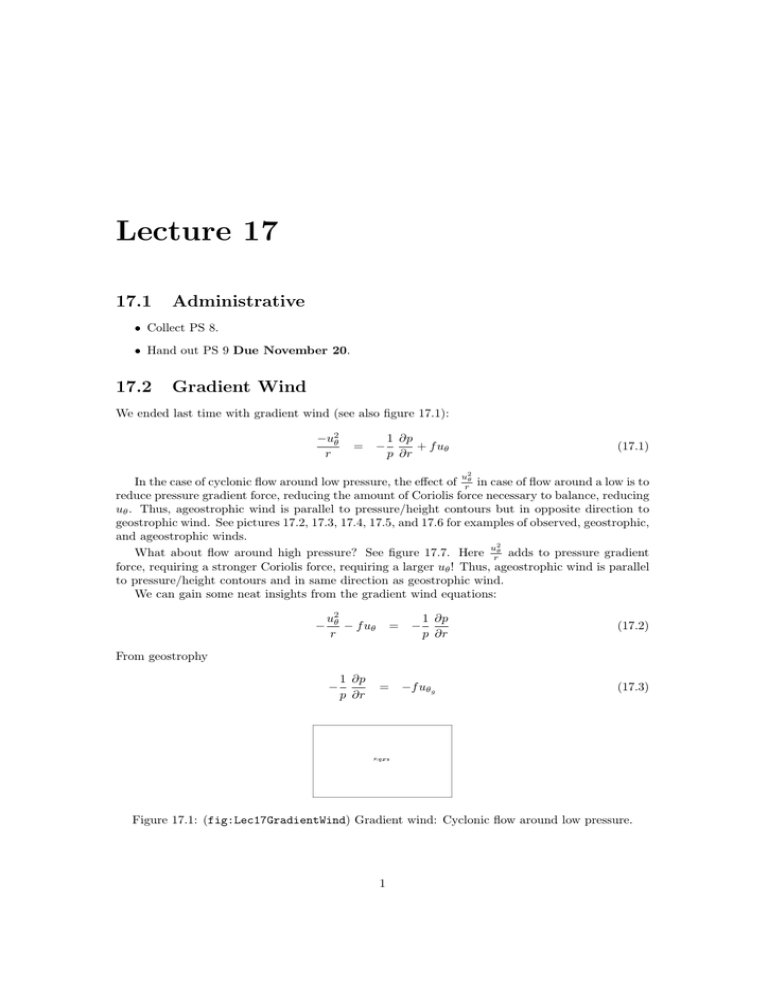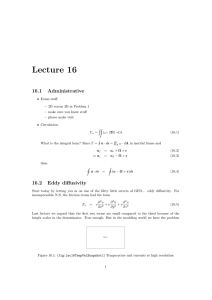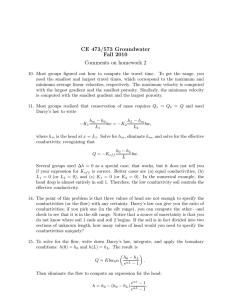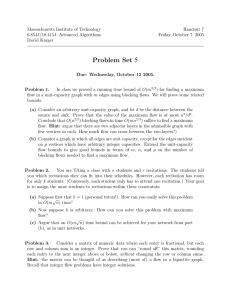Lecture 17 17.1 Administrative 17.2
advertisement

Lecture 17 17.1 Administrative • Collect PS 8. • Hand out PS 9 Due November 20. 17.2 Gradient Wind We ended last time with gradient wind (see also figure 17.1): −u2θ r = − 1 ∂p + f uθ p ∂r (17.1) u2 In the case of cyclonic flow around low pressure, the effect of rθ in case of flow around a low is to reduce pressure gradient force, reducing the amount of Coriolis force necessary to balance, reducing uθ . Thus, ageostrophic wind is parallel to pressure/height contours but in opposite direction to geostrophic wind. See pictures 17.2, 17.3, 17.4, 17.5, and 17.6 for examples of observed, geostrophic, and ageostrophic winds. u2 What about flow around high pressure? See figure 17.7. Here rθ adds to pressure gradient force, requiring a stronger Coriolis force, requiring a larger uθ ! Thus, ageostrophic wind is parallel to pressure/height contours and in same direction as geostrophic wind. We can gain some neat insights from the gradient wind equations: − u2θ − f uθ r = − 1 ∂p p ∂r = −f uθg 1 ∂p p ∂r (17.2) From geostrophy − (17.3) Figure 17.1: (fig:Lec17GradientWind) Gradient wind: Cyclonic flow around low pressure. 1 Figure 17.2: (fig: Figure 17.3: (fig: Lec17Geostrophic1) Example 1: Geostrophic wind. Lec17Ageostrophic1) Example 1: Ageostrophic wind. Figure 17.4: (fig: Figure 17.5: (fig: Figure 17.6: (fig: Lec17Observed2) Example 2: Observed wind. Lec17Geostrophic2) Example 2: Geostophic wind. Lec17Ageostrophic2) Example 2: Ageostrophic wind. Figure 17.7: (fig Lec17GradientWindHigh) Gradient wind: Anticyclonic flow around high pressure. 2 Substitute: u2 − θ − f uθ ru θ uθ +f r uθ uθ +1 fr uθg uθ = −f uθg (17.4) = f u θg (17.5) = u θg (17.6) = uθ +1 fr (17.7) This says three things: 1. uθ fr > 0 ⇒ cyclonic flow, uθg > uθ 2. uθ fr < 0 ⇒ anticyclonic flow, uθg < uθ 3. uθ fr = 0 (r = ∞), uθg = uθ (thank goodness!) 17.3 Gradient Flow: Cyclonic/Antocyclonic, High/Low We can say a bit more about the gradient flow: u2θ 1 ∂p + f uθ − =0 r p ∂r (17.8) Solving quadratic equation: ⇒ √ b2 − 4ac 2a −f ± f 2 − 4 1r − ρ1 = 2 1r rf 4 ∂p r = − f2 + ± 2 2 rρ ∂r r2 f 2 rf r ∂p = − ± + 2 4 ρ ∂r x = uθ uθ uθ −b ± (17.9) ∂p ∂r (17.10) (17.11) (17.12) Dividing by rf yields: uθ rf But uθ rf 1 = − ± 2 1 1 ∂p + = R0 4 ρf 2 r ∂r is something like a Rossby number! This means pressure. Let’s plot the solution as a function of R0 and Assume we are in the northern hemisphere, so f > 0. • ⇒ R0 > 0 ⇒ uθ > 0 ⇒ cyclonic flow • ⇒ R0 < 0 ⇒ uθ < 0 ⇒ anti-cyclonic flow • ∂p ∂r > 0 ⇒ low pressure at r = 0 3 1 ρf 2 r 1 ρf 2 r ∂p ∂r ∂p ∂r , (17.13) is some sort of non-dimensional see figures 17.8 and 17.9. Figure 17.8: (fig:Lec17GradientWindRegimes1) Gradient wind regimes solutions from equation 17.13. Figure 17.9: (fig:Lec17GradientWindRegimes2) Gradient wind regimes solutions from equation 17.13, with some description. Figure 17.10: (fig:Lec17CyclonicHigh) Gradient wind: Cyclonic flow around high pressure ⇒ no balance! 4 Figure 17.11: (fig:Lec17HighLow) Pressure as a function of r. Figure 17.12: (fig: • ∂p ∂r Lec17AnticyclonicHigh) Gradient wind: Anticyclonic high. < 0 ⇒ high pressure at r = 0 Why is there no solution for r0 > 0, ∂p ∂r < 0? In this case all the forces are acting in one direction and there is no balance – see figure 17.10. Thus highs can only be cyclonic. Notice that the pressure gradients for the cyclonic high get no greater (in an absolute sense) than 14 , while those for lows are (theoretically) unbounded. This means that the winds associated with highs are more gentle than those associated with lows. Also consider the square root term: 1 1 r 1 ∂p 1 ∂p + = + (17.14) 4 ρf 2 r ∂r r 4 ρf 2 ∂r ∂p For negative ∂p ∂r (a high) to keep the quantity positive as r → 0, ∂r → 0. Thus the pressure gradients in the middle of highs are nearly zero and (Jim – The bottom is cut off of the page and I can’t read it). By contrast, if ∂p ∂r > 0, there is no such constraint to maintain a positive quantity and the pressure gradients and thereby winds in the middle of lows can be quite nasty. Why do we have an upper limit on the magnitude of the negative pressure gradient in anticyclonic highs (see figures 17.11 and 17.12)? Here you have coriolis balancing both the pressure gradient force and the centrifugal force. A greater ∂p ∂r would require a larger f uθ but also have a u2 larger rθ . For large uθ ’s the uθ just can’t balance (Jim – The bottom is cut off of the page and I can’t read it). ∂p Why don’t we see this limit of ∂p ∂r in the cyclonic low (see figure 17.13)? Here, a larger ∂r is balanced both by f uθ and gradients. u2θ r . Figure 17.13: (fig: So the balance can be maintained even under large pressure Lec17CyclonicLow) Gradient wind: Cyclonic low. 5 Figure 17.14: (fig:Lec17AnticyclonicLow) Gradient wind: Anticyclonic low. Figure 17.15: (fig:Lec17CyclostrophicAnticyclonicLow) Anticyclonic flow around a low: A balance between the pressure gradient force and the centrifugal force. 17.4 Cyclostophic flow According to our plot, we can also get anti-cyclonic lows (see figure 17.14), but note that this is only for Rossby numbers with magnitudes larger than 1. Coriolis is only deemed important for (Jim – The bottom is cut off of the page and I can’t read it). So the better picture to draw is that seen in figure 17.15. The equation governing flow in this regime is u2θ r = 1 ∂p ρ ∂r (17.15) This is the cyclostophic flow. We can have both cyclonic and anti-cyclonic lows (see figures 17.16, 17.17). You can never have highs in cyclostrophic balance, because pressure gradient force and centrifugal force are in the same direction (see figure 17.18). We can define a cyclostrophic wind: u2θ r uθ 1 ∂p ρ ∂r r ∂p = ρ ∂r = (17.16) (17.17) Note: ∂p ∂r must be > 0 ⇒ low. I’m not sure if we know exactly what the pressure drop is in the middle of a tornado, but estimates put it at around 100 mb: Figure 17.16: (fig:Lec17CyclostrophicAnticyclonicLow2) Cyclostrophic balance: Anticyclonic low. 6 Figure 17.17: (fig:Lec17CyclostrophicCyclonicLow2) Cyclostrophic balance: Cyclonic low. Figure 17.18: (fig:Lec17CyclostrophicAntiyclonicHigh) Cyclostrophic balance: Anticyclonic low 2 • ∆p = (100mb)(100 N/m mb ) = 10000N/m 2 • ∆r ≈ 500m • ρ ≈ 1 kg/m3 (10000) • uθ = 500 for velocity in wall of tornado 1 500 • uθ = 100m/s ≈ 220mph! 17.5 Isallobaric flow We’ve talked about inertial flow, geostrophic flow, gradient flow, and cyclostrophic flow. Next, the isallobaric flow. See pictures 17.19, 17.20, 17.21, 17.22 for examples and motivation. We have cross-isobaric flow in the region entering and exiting a jet. What is causing it? See figure 17.23 for a schematic. Consider: x: ∂u + (u · ∇)u ∂t (u · ∇)u 1 ∂p + fv ρ ∂x = fv = − (17.18) (17.19) Here the first term is crossed out because we are in a time-independent regime and the pressure gradient term is lost because we are moving along a straight line in x. This leads to a balance Figure 17.19: (fig:Lec17Geostrophic3) Example 3: Geostrophic wind. 7 Figure 17.20: (fig:Lec17Ageostrophic3) Example 3: Geostrophic wind. Figure 17.21: (fig:Lec17Geostrophic4) Example 4: Geostrophic wind. Figure 17.22: (fig:Lec17Ageostrophic4) Example 4: Geostrophic wind. Figure 17.23: (fig:Lec17TubeFlow) Schematic to isallobaric flow. 8 Figure 17.24: (fig:Lec17TubeFlowDivergence) This isallobaric ageostrophic wind is of extreme interest to weather forecasters. Divergence creates upwelling and can initiate convection. Figure 17.25: (fig: term. Lec17TimeChangingFlow1) Isallobaric flow from the time rate of the change between the coriolis force and the non-linear acceleration term. Consider only the first term of (u · ∇)u: u ∂u u ∂u = fv ⇒ v = ∂x f ∂x (17.20) ∂p Increase in ∂y drives flow in the y direction and coriolis doesn’t have time to turn all that v to the right. (Jim – You may want to elaborate on this statement a bit more). At the entrance to the jet, u increases with x so the RHS is positive and v is positive as observed. At the exit of the jet, u decreases with x so the RHS is negative as observed. This isallobaric ageostrophic wind is of extreme interest to weather forecasters (see figure 17.24). Divergence creates upwelling and can initiate convection. Storms tend to form to the right of entrances to jets, and to the left of exits. Particularly relevant/interesting in the spring when this can fire off major convective storms in the plain states. The isallobaric flow we’ve just considered comes from the nonlinear advection terms balancing Coriolis. It can also come from the time rate of the change term (see figures 17.25, 17.26). Consider: x: ∂u + (u · ∇)u ∂t ∂u ∂t ⇒ v = − 1 ∂p + fv ρ ∂x = fv = 1 ∂u f ∂t (17.21) (17.22) (17.23) Figure 17.26: (fig: Lec17TimeChangingFlow2) Isallobaric flow from the time rate of the change term. ∂u ∂t > 0 ⇒ v > 0 9 Figure 17.27: (fig:Lec17Friction1) Three way balance, friction drawn in but not accounted for. This doesn’t work, there is no balance. Figure 17.28: (fig:Lec17Friction2) Three way balance, friction accounted for. This works, there is a balance. ∂p You can think of this as ∂y driving an increase v, and the coriolis force doesn’t have time to turn it all the way to the right. Or, you can think of this as ageostrophic v being turned to the right and accelerating/decelerating the flow. Kinematics don’ address causality. 17.6 Balance with friction (Q1). All the balances we’ve considered so far have ignored viscosity. THis is fine when we are far from boundaries, but what happens when we get close to the surface? Let’s throw some viscosity back into our momentum equations: Du Dt x: = 1 ∂p + f v + νH ∇2 u ρ ∂x (17.24) We know we can ignore the LHS when R0 1, when can we ignore friction? νH ∇ 2 u U f u νH 2 L νH 1 ≡ Ekman number f L2 fv (17.25) (17.26) (17.27) So, for Ek 1, viscosity can be neglected. Let’s imagine we’re in a scenario where R0 1, Ek ∼ 1: x: y: 1 ρ 1 ρ ∂p ∂x ∂p ∂x = f v + νH ∇2 u (17.28) = −f u + νH ∇2 v (17.29) (17.30) It’s a three-way balance between pressure gradient, coriolis, and friction. Trying to draw a picture might give what is seen in figure 17.27, but what is really going on it in figure 17.28. (Q2). In the later figure we have a balance. The x component of friction balances x component of Coriolis. The y component of friction and coriolis balance the pressure gradient. The impact 10 Figure 17.29: (fig:Lec17LawConvergence) Schematic of surface winds converging around a low. Figure 17.30: (fig:Lec17Surfacewind) Surface winds around a low show convergence. of the friction is to cause the balanced flow to cross lines of constant pressure! This is why wind spirals into the center of a low (only at the surface!) and spirals outwards from the center of a high (see figures 17.29, 17.30 for schematic and observations, respectively). How much cross isobaric flow is there (see figure 17.31)? Balance in the x-direction shows F cos θ = C sin θ F sin θ = = tan θ = θ, if θ small c cos θ νH ∇2 u θ= = Ek 2Ω × u (17.31) (17.32) (17.33) (Jim – There is some more stuff that was cut off at bottom of the page). Figure 17.31: (fig:Lec17Friction3) Cross isobaric flow in the surface Ekman layer. 11







